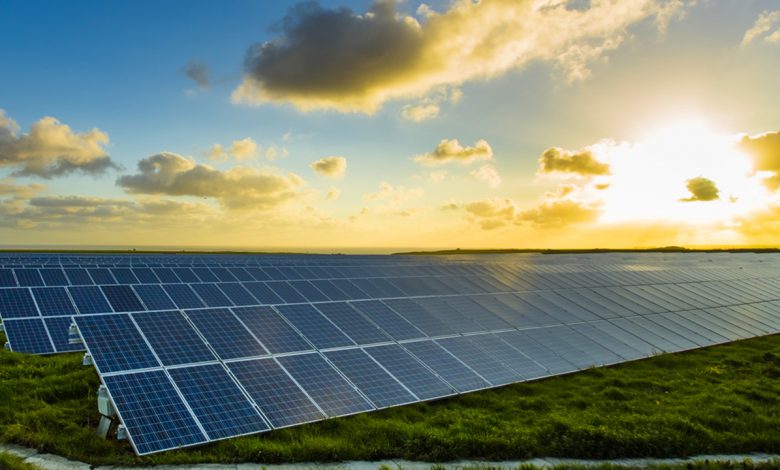Daily Current Affairs for UPSC
Production-linked incentive (PLI) scheme for high-efficiency solar modules
Syllabus- Government Policies and Interventions [GS Paper-2]

Context- Production-linked incentive (PLI) funds for high-efficiency solar modules were increased in the Union budget.
Key Highlights
-
- A solar panel is a collection of photovoltaic (PV) cells that take in sunlight and turn it into electricity.
- Working:
- Energy in the form of photons is absorbed when sunlight strikes the semiconductor in the solar PV cell.
- Numerous electrons are excited as a result of this energy absorption, and they then freely move throughout the cell.
- An electric field is precisely what the solar cell is made to do.
- The electrons are compelled to flow in a particular direction by this electric field, toward the cell’s electrical terminals.
- The amount of electricity that can be produced by each cell determines the strength of this flow, which is referred to as an energy current.
- The panel becomes a source of electrical energy when the electrons reach terminals and the current flows through wires.
- India’s manufacturing:
-
- India has increased its PV capacity significantly over the past decade, reaching over 50 GW by 2022 from less than 10 MW in 2010.
- India intends to deploy approximately 500 GW of renewable energy by 2030, of which 280 GW are anticipated to come from solar PV. Until 2030, this calls for 30 GW of solar capacity annually.
- India’s current manufacturing capacity for solar modules is approximately 15 GW per year; imports provide the remaining capacity.
- Along with Vietnam and Malaysia, China supplies an estimated 85% of this import requirement. Since 2014, solar imports have been worth $12.93 billion, or Rs 90,000 crore.
India’s Manufacturing Obstacles
- The process of making solar cells requires a lot of technology and is complicated.
- To construct cutting-edge manufacturing facilities, technology access is required.
- Companies that have invested millions of dollars in research and development are unlikely to make it easier or cheaper for India to access the most recent technologies.
- The production of solar cells requires a significant amount of capital.
- The cost of debt in India, which is 11%, is the highest in the Asia-Pacific region, while it is about 5% in China.
- Every 8 to 10 months, solar cell technology is improved, making manufacturing inefficient for newcomers.
- Despite 100% foreign direct investment (FDI) in the renewable energy sector, the lack of an integrated setup and economies of scale result in higher domestic production costs for solar panel manufacturing.
- The panel’s most expensive raw material, silicon wafer, is not made in India.
Government initiatives
- The Union Government launched a production linked incentive (PLI) scheme worth Rs 19,500 million titled “national programme on high efficiency solar PV modules” with the intention of attracting investments worth Rs 94,000 million in the sector.
- The Centre has decided to provide uniform financial support equal to 50% of the project cost for setting up semiconductor fabrication plants in order to address the shortage of raw materials for silicon wafers.
- The government has mandated that a solar power producer must compulsorily source a certain percentage of solar cells and modules from local manufacturers in order to be able to benefit from the government guarantee to purchase the energy produced.
- This is done so that a solar power producer can take advantage of the government guarantee to purchase the energy produced.
- The Modified Special Incentive Package Scheme (M-SIPS) of the Ministry of Electronics & Information Technology provides a subsidy of between 20 and 25 percent for investments in capital expenditures.
India’s Solar Goals
- From 0.5GW in 2011 to 55GW in 2021, India’s solar industry has expanded at a CAGR of roughly 59 percent.
- The National Solar Mission (NSM) set a 20GW target for total installed capacity by 2022.
- The goal was lowered to 100 GW in 2015, and the government set a solar target of 300 GW by 2030 in August 2021.
- Around 30% of India’s 100GW (2022 ) sunlight based target actually remains neglected.
Government Schemes
- PM KUSUM: The scheme aims to add 30,800 MW of solar and other renewable capacity by 2022, with a total of Rs. 34,422 Trillions
- Solar Park Scheme: In a number of states, the Solar Park Scheme intends to construct several solar parks, each with a capacity of nearly 500 MW.
- Atal Jyoti Yojana (AJAY): In states where less than half of the households use grid power (according to the 2011 Census), the AJAY program, which allows for the installation of solar street lighting (SSL) systems, was launched in September 2016.
- National Solar Mission: It is a major initiative of the Indian government and state governments to address India’s energy security issue and promote ecologically sustainable growth.
- SRISTI Scheme: The Solar Transfiguration of India (SRISTI) program promotes rooftop solar power projects in India. Sustainable rooftop implementation.





.png)



